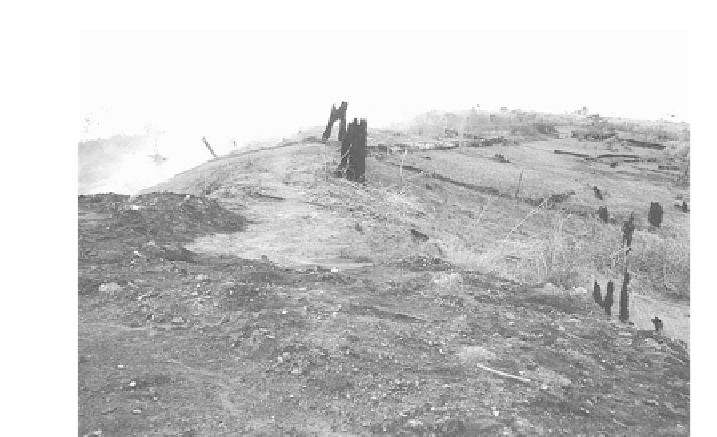Geography Reference
In-Depth Information
Figure 5-8
This Kalimantan fire has been burning since 1983.
More than 9 million acres (80,000 ha) of forest
and its resident wildlife have been destroyed.
Photograph courtesy of B. A. Weightman
.
subsidiary of KS Oils Limited of Madhya Pradesh, which
specializes in mustard oil. KSNR acquired 50,000 acres
(20,000 ha) of Indonesian forest in 2008 and has recently
added another 35,000 acres (14,000 ha). All this acreage
is to be cleared for palm oil production.
However, all is not well with palm oil production.
Sci-
ence
, a leading research journal, has designated the crop as
“filthy .” In order to develop plantations, forests are cleared
by burning and CO
2
and other greenhouse gases are
spewed into the atmosphere, thereby increasing global
warming Figure 5-8. Now Indonesia is the world' is third
largest carbon emitter after the United States and China.
More than 26 percent of both Indonesian and
Malaysian oil palm plantations are on peat lands. Esti-
mates are that for each ton of palm oil produced, an aver-
age of 20 tons of CO
2
will be emitted from peat
decomposition alone. A United Nations study demon-
strates that of the estimated 2 gigatons of CO
2
released
by Indonesia, 600 million tons are generated by the de-
composition of peat and 1,400 million tons are lost
through the seasonal fires.
Aside from contributing to global warming, palm
oil monoculture in tropical ecosystems has an array of
other harmful environmental consequences. Water-
catchment areas are ruined; animal habitats are de-
stroyed; and unhealthy haze from fires spreads across
large swaths of Southeast Asia. Without peat wetlands
that store rain water, the water runs off, leading to ero-
sion of precious topsoils and reduction of fresh ground-
water for drinking.
Beyond the loss of forest ecosystems, palm oil produc-
tion leaves piles of trash. In 2001, Malaysia' s production of
7 million tons of crude palm oil generated 9.9 million tons
of solid oil wastes, palm fiber and shells, and 10 million
tons of palm oil mill effluent. The effluent is a polluted
mix of crushed shells, water, and fat residues that are
shown to have negative impacts on aquatic ecosystems.
Between 1985 and 2005, roughly a third of Borneo' s
rainforest has disappeared, felled by indiscriminate log-
ging or cleared for palm oil plantations. One alarming
2001 study , from the University of Singapore, predicts
that a third of Asian forest plant and animal species will
become extinct in the twenty-first century!
IGNORING THE DOWNSIDE OF PALM OIL
PRODUCTION
India, China, and Europe see biofuels as making up 10
percent of motor fuels by 2020. Indonesia argues that
the palm oil industry will create as many as 3.5 million
jobs, thereby alleviating poverty . An assistant to Indone-
sia' s Minister of Energy notes that “all the forests have
not been used yet.” She observed that just in Kalimantan
(the Indonesian part of Borneo), there are more than
13.6 million acres (5.5 million hectares) “available”—an
area larger than Denmark. Also, there are another 22.2 mil-
lion acres (9 million ha) available elsewhere in the coun-
try . Indonesia' s environmental watchdog,
W alhi,
believes
that coveting “available” land has nothing to do with oil
palms but rather is an attempt to make money from har-
vesting valuable wood.
W alhi
notes that millions of acres
have been cleared of trees but have not been planted with
palm oil. Government efforts to curb illegal logging have
been spotty at best. Corruption and collusion with

















Search WWH ::

Custom Search